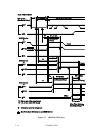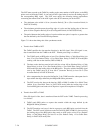C156-E097-01EN 7 - 19
(4) Timeout procedure
If the INIT cannot detect the response from TARG when the Selection Timeout Dalay (or
longer) has passed after starting the SELECTION phase, the timeout procedure shall be
performed through one of the following schemes:
• The INIT asserts the RST signal and creates the RESET condition.
• The INIT maintains SEL signal true and releases the data bus (SCSI IDs). Subsequently, the
INIT waits for the response from TARG for at least 200 µs (Selection About Time) + 90 ns
(Deskew Delay × 2). If no response is detected, the INIT releases the SEL signal allowing
the SCSI bus to go to the BUS FREE phase. If the INIT detects the response from TARG
during this period, the INIT considers the SELECTION phase to have completed normally.
7.5.4 RESELECTION phase
The TARG selects an INIT during the RESELECTION phase. The RESELECTION phase can
only be used in systems with ARBITRATION phase implemented.
The TARG reconnects the INIT using this RESELECTION phase when the TARG restarts the
command processing that is in the disconnect state on the SCSI bus.
(1) Start sequence
A TARG performs the RESELECTION phase in the following sequence after obtaining control
of the SCSI bus through the ARBITRATION phase:
1) The TARG waits at least 1.2 µs (Bus Clear Delay + Bus Settle Delay) after asserting the
SEL signal.
2) The TARG sends the SCSI ID of TARG itself and INIT and asserts the I/O signal. (The
TARG can obtain control of the SCSI bus by asserting the I/O signal.)
3) The TARG releases the BSY signal after waiting at least 90 ns (Deskew Delay × 2), then
wait at least 400 ns (Bus Settle Delay) before looking for the response from the INIT (BSY
signal).


















